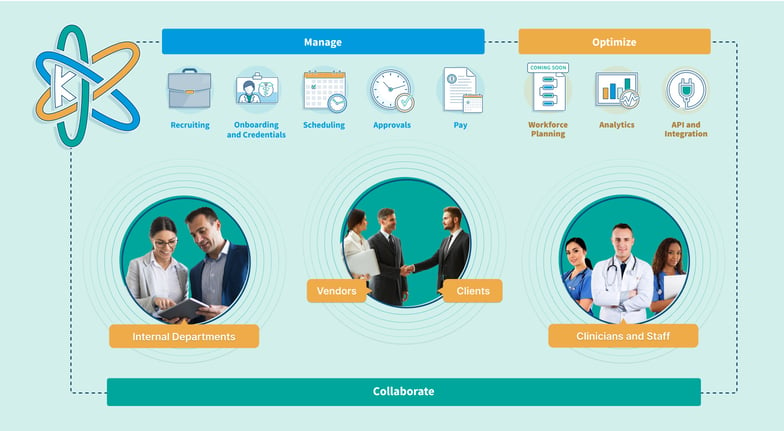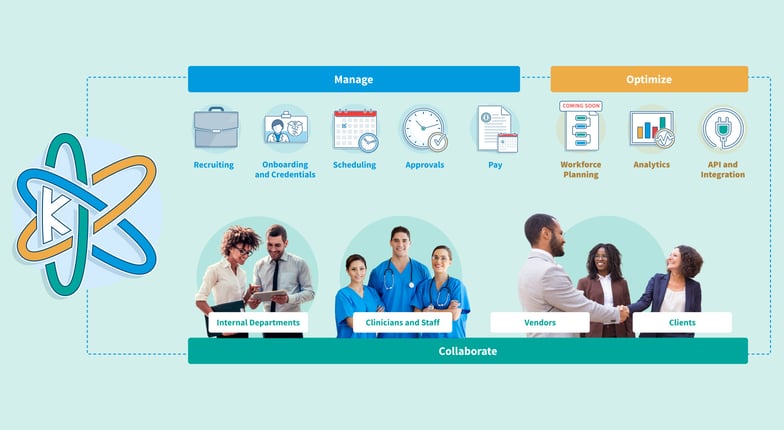 Sarah Ramsey
Sarah RamseyImagine a world where healthcare teams work together seamlessly. A world where recruitment, credentialing, scheduling, and finance are all aligned toward a common goal. That's the power of RosterOps.
RosterOps is a game-changing approach that brings order to the chaos of healthcare workforce management. It breaks down silos between departments, clinicians, and clients/vendors ensuring everyone is working towards the same objectives.
In this article, we'll dive deep into the core pillars of RosterOps - collaboration, process/workflows, and data/technology. You'll learn how to implement a RosterOps framework step-by-step and see real-world examples of its transformative impact.
Whether you're an executive looking to optimize spend, an administrator aiming to streamline operations, or a clinician seeking to provide the best possible care, this guide is for you.

The Need for a New Approach to Healthcare Workforce Management
Healthcare workforce management is a complex and multifaceted challenge that requires a new approach to ensure effective collaboration, visibility, and efficiency. With 13 or more different personas involved in getting an advanced clinician to work a single shift, and the majority of organizations relying on collaboration with up to 50 third-party staffing agencies to ensure patients are seen, the complexity of the staffing process is exponentially increased. Furthermore, the variety of labor categories and the need to collaborate with clinicians themselves for engagement and burnout reduction add to the intricacy of workforce management.
Healthcare Faces Some Specific Workforce Challenges
Healthcare organizations face unique workforce challenges that require special attention and innovative solutions. These challenges include, but aren’t limited to:
Multiple concurrent workflows, such as credentialing requirements, malpractice, state licensure, privileges, hiring, internal onboarding, and organization and site-level training and standard operating procedures.
Multi-layer approval channels involving the business side, clinical side, site level, and centralized departments.
Shortages have led to the emergence of strategic care models and a variety of labor categories, including full-time employed, agency locum, float pools, 1099s, part-time W2, and traveler W2 programs.
Ensuring legal and operational commitments in contracts are matched in scheduling and payments, such as shift minimums, consecutive shifts/hours, and minimum consecutive shifts for patient continuity.
Skill and credential matching for efficient deployment of care teams across various care settings.
Complex compensation and scheduling, with organizations striving to have compensation mirror workload and desirability, leading to various rate differentials and rate types for premiums on days/nights, weekends, holidays, and different activities like call vs. regular pay.
Limited Technology Options, built specifically for healthcare, Exist to Uniting Teams
Current technology options for uniting teams in healthcare workforce management are limited and often can’t address the industry's specific needs. Some of these options are:
CRM/ATS:
Mostly horizontal (industry agnostic) options built for sales, lacking the nuances of healthcare workforce management.
VMS:
Built for managing contingent/third-party staff, offering only a piece of the staffing puzzle with limited scheduling capabilities, collaboration/project management tools and reporting.
Schedulers:
Inability to utilize the full potential without relevant credentials, expirations, skill, and onboarding data, and lacking spend management and compensation management visibility. They are also lacking collaboration with external vendors and clients to get the schedule optimally filled.
Project management software:
Requires extensive configuration and lacks robust scheduler capabilities with the team and spend calculation features.
Email, Excel, and standing phone calls:
Used to fill collaboration gaps, requiring manual data tracking and recurring meetings leaving each team to maintain and update their own source of truth.
RosterOps is a Transformative Methodology
RosterOps is a transformative methodology that offers a collaborative approach to aligning recruitment, credentialing, operations, and finance for deploying clinical workforces within and between organizations. It aims to streamline workforce management processes, optimize spend, drive retention, and deliver quality care.
RosterOps provides a cohesive caregiver delivery operations framework, uniting goals, defining roles, and enabling an integrated approach to delivering high patient care, and operational and financial targets. This holistic approach depends on people, process, data, and technology, with an efficient process relying on a Workforce Relationship Management (WRM) platform built specifically for healthcare.
RosterOps aligns all teams across the full clinician life cycle, breaking down silos between departments and ensuring teams have the necessary data for their next new start, schedule, or payroll run.
Emergence of a New Technology Category for Complex Industries Like Healthcare

Workforce Relationship Management (WRM) is emerging as a new scheduling and staffing technology category designed to address the unique challenges faced by complex industries like healthcare. WRM provides a centralized collaboration tool that helps operators manage their practices (care locations) and rosters (caregivers) effectively. It enables teams to stay organized across critical task management workflows, such as credentialing, expirations, state licenses, privileges, overall onboarding, and more.
WRM platforms, like Kimedics, allow teams to build collaboration handoffs, set up templated checklists, and create flags and warnings to proactively highlight potential issues across the entire clinician lifecycle. By providing instant visibility into team tasks at the status level and individual checklist items, WRM ensures that teams hit their goals and maintain a healthy roster.
Let’s take a quick peek into what you can expect in this eBook:
Chapter 1: The 3 Pillars of RosterOps
Chapter 2: The RosterOps Framework in Action
Chapter 3: Overcoming Common RosterOps Challenges
Chapter 4: The Benefits of Adopting RosterOps
Chapter 5: Getting Started with RosterOps
Chapter 6: Conclusion and Next Steps
Get ready to revolutionize the way you manage your healthcare workforce with RosterOps. Let’s dive in!
CHAPTER 1
The 3 Pillars of RosterOps
RosterOps is a transformative approach to healthcare workforce management that relies on three essential pillars: collaboration, process/workflows, and data/technology. By focusing on these core elements, organizations can streamline their operations, optimize spend, improve retention, and ultimately deliver high-quality patient care. Let's explore each of these pillars in more detail.
Pillar 1: Collaboration
The critical role of a centralized RosterOps team
RosterOps teams play a vital role in bringing together recruitment, credentialing, operations, and finance teams to ensure a cohesive caregiver delivery operations framework. These teams are responsible for:
Facilitating cross-functional alignment and communication.
Breaking down silos between departments.
Turning visitors into leads.
Key roles and responsibilities
Within a RosterOps team, each member has specific roles and responsibilities that contribute to the overall success of the workforce management process. These roles may include recruitment specialists, credentialing experts, operations managers, and financial analysts.
By working together and leveraging their individual strengths, RosterOps team members can effectively tackle the complexities of healthcare workforce management.
Pillar 2: Process/Workflows
Standardizing and optimizing end-to-end processes
To ensure efficient and effective workforce management, RosterOps teams must focus on standardizing and optimizing end-to-end processes and the stakeholders responsible at each step in the process. This involves tasks such as mapping the clinician lifecycle from recruitment to offboarding, scheduling to payment approvals as well as identifying bottlenecks and inefficiencies. RosterOps teams are also responsible for implementing best practices and streamlined workflows.
Designing efficient workflows for the clinician lifecycle
RosterOps teams should design workflows that cover the entire clinician lifecycle, including:
Recruitment and onboarding.
Credentialing, privileging, state licensure, payor enrollment (new and expiration monitoring).
Scheduling and deployment.
Time tracking and payroll.
Performance management and retention.
By creating efficient workflows for each stage of the clinician lifecycle, RosterOps teams can minimize errors, reduce time-to-fill, and improve overall workforce management.
Pillar 3: Data/Technology
Establishing a data-driven decision-making framework
Data and technology play a crucial role in RosterOps by enabling organizations to make informed, data-driven decisions. To establish a data-driven decision-making framework, RosterOps teams should:
Identify key metrics and KPIs for RosterOps success.
Implement systems and processes for collecting, analyzing, and reporting data.
Use data insights to continuously improve workforce management strategies.
The importance of a unified Workforce Relationship Management (WRM) platform
A unified Workforce Relationship Management (WRM) platform is essential for RosterOps teams to effectively manage their healthcare workforce. A WRM platform needs to offer centralized data management, real-time visibility into workforce metrics, and streamlined communication and collaboration tools for internal collaboration, workforce collaboration as well as collaboration with vendors and clients.
Leveraging a WRM platform with automated workflows and processes, helps RosterOps teams break down data silos, improve efficiency, and make data-driven decisions to optimize their workforce management strategies.
Essential features and capabilities of RosterOps technology
To support the RosterOps methodology, it’s a good idea for organizations to look for technology solutions that offer the following essential features and capabilities:
Practice and User Management - Define the care locations your teams are dispatched to.
Partner Management - Define the outside organizations you collaborate with like staffing suppliers or clients.
Recruitment (Job Dispatching) and onboarding tools for both internal and external workforce (as a vendor (VMS) and client portal).
Credential, license, and profile management or entire caregiver network.
Scheduling and deployment functionality.
Time approval and payroll integration.
Performance management and analytics.
By investing in technology that supports these critical functions, RosterOps teams can effectively deploy their workforce and drive better outcomes for their organizations.
In summary, the three pillars of RosterOps - collaboration, process/workflows, and data/technology - form the foundation of a successful healthcare workforce management strategy. When you focus on these core elements, organizations can overcome common challenges in the healthcare workforce.
CHAPTER 2
The RosterOps Framework in Action

Implementing RosterOps involves a series of strategic initiatives and tactical steps that span across planning, process design, workflow automation, data management, and performance optimization.
Planning and Strategy
Aligning RosterOps objectives with organizational goals
The first step in implementing RosterOps is to align the framework's objectives with the organization's overall goals. This involves:
Identifying key performance indicators (KPIs) for workforce management.
Setting targets for cost optimization, staff retention, and patient care quality.
Communicating the importance of RosterOps to stakeholders across the organization.
Designing compensation structures and org charts
To support RosterOps, organizations must design compensation structures and org charts that promote collaboration and accountability. For starters this may entail creating a centralized RosterOps team with clearly defined roles and responsibilities. You’ll also want to consider developing compensation models that incentivize performance in alignment with your strategy. Finally, it’s a good idea to establish reporting lines and decision-making protocols.
Process Design and Management
Mapping the clinician lifecycle
To optimize workforce management, RosterOps teams must map the entire clinician lifecycle from recruitment to the first paycheck to offboarding. This involves tasks such as identifying all touchpoints and handoffs between departments and documenting current processes and workflows as well as what your ideal process should be. RosterOps teams should always be working on identifying opportunities for improvement and standardization.
Standardizing contracts, documents, and forms
Streamlining administrative tasks is critical for efficient workforce management. RosterOps teams should focus on standardizing employment contracts and agreements, credentialing and privileging documents, and onboarding and training materials.
Workflow Automation
With workflow automation, there is a balancing act. The goal is to streamline clinician work without losing the human connection.
Streamlining manual processes
To reduce administrative burden and improve efficiency, RosterOps teams should identify manual processes that can be automated. A few manual processes you may be able to streamline are applicant tracking, schedule reminders, expiration tracking, and other analytics. Additionally, you could automate things like shift scheduling, time tracking, and payroll processing.
Implementing closed-loop and automated expiration monitoring workflows
Ensuring clinician credentials and licenses remain up-to-date is critical for compliance and patient safety. RosterOps teams should implement closed-loop and automated expiration monitoring workflows that take the following steps:
Alert clinicians and managers of upcoming expirations.
Provide easy access to resources for renewal and support.
Track compliance metrics and report on performance, productivity and team capacity.
Data Management and Analytics
Data transparency in healthcare workforce management empowers organizations to make informed decisions, optimize operations, and improve care quality by providing real-time visibility into comprehensive, reliable data across all critical systems and processes.
Developing a data governance strategy
To support data-driven decision making, RosterOps teams must develop a robust data governance strategy. This involves:
Identifying data sources and systems of record.
Establishing data quality standards and metrics.
Implementing policies and procedures for data access, security, and privacy.
Enabling data sharing and visibility across teams
Breaking down data silos is essential for effective RosterOps. Organizations should invest in technology solutions that enable real-time data sharing and visibility across departments. You also want to keep an eye out for solutions that offer centralized reporting and analytics as well as collaborative decision-making and problem-solving.
Performance Monitoring and Optimization
Data transparency in healthcare workforce management empowers organizations to make informed decisions, optimize operations, and improve care quality by providing real-time visibility into comprehensive, reliable data across all critical systems and processes.
Establishing metrics and reporting cadences
To continuously improve workforce management, RosterOps teams must establish key metrics and reporting cadences. For example, defining and tracking KPIs for recruitment, onboarding, scheduling, and retention. It’s a good idea to set targets and benchmarks for performance and conduct regular performance reviews and feedback sessions.
Conducting forecast analysis and identifying efficiencies
RosterOps teams should leverage data analytics to conduct forecast analysis and identify opportunities for efficiency gains. This involves:
Analyzing historical data to predict future staffing needs.
Identifying patterns and trends in workforce management metrics.
Identify recruitment gaps to get ahead of turnover or growth.
Conducting root cause analysis of performance gaps and inefficiencies.
By following this RosterOps framework, healthcare organizations can break down silos, streamline processes, and drive better outcomes for their workforce and patients. The key is to approach RosterOps as an ongoing journey of continuous improvement, rather than a one-time initiative.
CHAPTER 3
Overcoming Common RosterOps Challenges

Implementing RosterOps can be a game-changer for healthcare organizations, but the journey is not without its challenges. In this chapter, we'll explore some of the most common obstacles that organizations face when adopting RosterOps and provide practical strategies for overcoming them.
1. Resistance to Change
One of the biggest challenges in implementing RosterOps is overcoming resistance to change. For example, many organizations believe that simply investing in analytics tools will be enough to break down silos and improve workforce management. However, true collaboration and insight require more than just data. It requires a platform that enables teams to work together and make sense of the data in real-time.
To overcome this challenge, RosterOps leaders must:
To optimize workforce management, RosterOps teams must map the entire clinician lifecycle from recruitment to the first paycheck to offboarding. This involves tasks such as identifying all touchpoints and handoffs between departments and documenting current processes and workflows as well as what your ideal process should be. RosterOps teams should always be working on identifying opportunities for improvement and standardization.
Communicate the value of collaboration and shared decision-making.
Provide training and support to help teams adapt to new ways of working.
Celebrate early wins and share success stories to build momentum.
2. Inadequate Technology and Data Management
Many healthcare organizations rely on disparate systems and manual processes to manage their workforce, which can lead to data silos, errors, and inefficiencies.
To overcome this challenge, RosterOps teams must:
To optimize workforce management, RosterOps teams must map the entire clinician lifecycle from recruitment to first paycheck to offboarding. This involves tasks such as identifying all touchpoints and handoffs between departments, and documenting current processes and workflows as well as what your ideal process should be. RosterOps teams should always be working on identifying opportunities for improvement and standardization.
Assess current technology and data management practices.
Identify gaps and opportunities for improvement.
Invest in a unified WRM platform that can support end-to-end workforce management.
Develop policies and procedures for data governance and quality assurance.
3. Lack of Clarity in Roles and Responsibilities
This challenge is specifically related to key metrics like hitting start dates for new hires. Without clear ownership and accountability, important tasks can fall through the cracks, leading to delays and frustration.
To overcome this challenge, RosterOps teams must:
Define clear roles and responsibilities for each stage of the workforce management lifecycle.
Establish ownership and accountability for key metrics and outcomes.
Implement processes and workflows that support collaboration and communication.
Use technology to track progress and identify potential roadblocks.
4. Insufficient Resources and Expertise
Finally, many healthcare organizations struggle with insufficient resources and expertise when it comes to implementing RosterOps. Workforce management is a complex field, and it can be challenging to stay up-to-date with best practices.
To overcome this challenge, RosterOps teams must:
Invest in training and professional development for RosterOps team members.
Partner with external experts and consultants who can provide guidance and support.
Participate in industry forums and events to stay connected with peers and learn from their experiences.
Advocate for adequate resources and funding to support RosterOps initiatives.
Related: Check out our post Reinvigorating Purpose for Frontline Healthcare Professionals where we discuss challenges that administrators face such as preventing burnout and other stressors.
It's important to remember that change takes time, and there will be obstacles along the way. However, if you address these common challenges head-on, healthcare organizations can set themselves up for success in implementing a transformative RosterOps approach.
CHAPTER 4
The Benefits of Adopting RosterOps

Adopting RosterOps can bring numerous benefits to healthcare organizations, from improving operational efficiency to enhancing patient care quality. Let’s explore some of the key advantages that organizations can expect to see when they embrace the RosterOps framework.
1. Streamlining Onboarding and Decreasing Time-to-Fill
One of the most significant benefits of RosterOps is the ability to streamline the onboarding process for new hires. By automating key tasks like name clears, presentation approvals, interview handoffs, credentialing, privileging, and orientation scheduling, RosterOps can significantly reduce the time it takes to get new clinicians up and running. This not only improves the clinician experience but also helps organizations fill open positions more quickly, reducing the risk of understaffing and burnout.
2. Moving From Reactive to Proactive Management
Another key benefit of RosterOps is the shift from reactive to proactive management. With the time saved on manual work to get the visibility needed to operate, RosterOps teams can identify potential issues before they become problems, such as upcoming credential expirations or shifts in patient demand. This proactive approach allows organizations to make data-driven decisions and adjust their staffing strategies in real-time, rather than constantly playing catch-up.
3. Optimizing Schedules and Eliminating Uncovered Shifts
RosterOps can also help organizations optimize their scheduling practices, ensuring that the right clinicians are in the right place at the right time. Leveraging advanced scheduling algorithms and real-time data on clinician availability and patient needs, helps RosterOps teams create schedules that maximize coverage, and minimize spend while minimizing overtime and burnout. This not only improves operational efficiency but also enhances patient care quality by ensuring that patients have access to the care they need when they need it.
4. Enhancing Clinician Satisfaction and Retention
Clinician satisfaction and retention are critical challenges for many healthcare organizations, and RosterOps can play a key role in addressing these issues. By streamlining administrative tasks, providing greater flexibility and control over schedules, and improving communication and collaboration, RosterOps can help clinicians feel more engaged and supported in their work. This, in turn, can lead to higher job satisfaction, lower turnover rates, and better patient outcomes.
5. Controlling Costs and Hitting Budget Targets
RosterOps can also help organizations control costs and hit their budget targets by providing greater visibility into workforce spending and identifying opportunities for savings. By analyzing data on labor costs, overtime, and agency usage, RosterOps teams can identify areas where they may be overspending and adjust their strategies accordingly. Additionally, by optimizing schedules and reducing the need for last-minute staffing, organizations can minimize the use of expensive contingent labor and keep costs under control. Even just being able to provide rate visibility to those who need it can contribute to better financial scheduling decisions.
6. Fostering a Culture of Collaboration and Continuous Improvement
Finally, adopting RosterOps can help foster a culture of collaboration and continuous improvement within healthcare organizations. By breaking down silos and promoting cross-functional communication and decision-making, RosterOps encourages teams to work together towards common goals and to continuously seek out ways to improve their processes and outcomes. This culture of collaboration and improvement can lead to better patient care, higher staff satisfaction, and a more resilient and adaptable organization overall.
From streamlining operations and reducing costs to improving provider satisfaction and patient outcomes, RosterOps offers a powerful framework for transforming healthcare workforce management with unprecedented 360° visibility.
CHAPTER 5
Getting Started with RosterOps

Implementing RosterOps can seem like a daunting task, but with the right approach and tools, any healthcare organization can successfully adopt this transformative methodology. In this chapter, we'll walk through the key steps for getting started with RosterOps.
1. Discover Your RosterOps Management Style
The first step in getting started with RosterOps is to assess your organization's current state of workforce management. One useful tool for this is the RosterOps Quiz, which evaluates your organization across four key dimensions: people, process/workflows, data/technology, and collaboration. By taking the RosterOps Management Style Quiz, you can quickly identify areas of strength and opportunity and prioritize your implementation efforts accordingly.
2. Define Goals and Objectives
Once you have a clear understanding of your current state, the next step is to define your goals and objectives for RosterOps implementation. These might include reducing turnover, improving time-to-fill for open positions, enhancing care quality, or controlling labor costs. By clearly articulating your goals upfront, you can ensure that your RosterOps efforts are aligned with your overall organizational strategy and that you have a clear way to measure success.
3. Assess Your Current State
In addition to measuring your RosterOps Score, it's important to take a deeper dive into your current workforce management practices and identify any gaps or pain points. This might involve mapping out your current processes, analyzing your technology stack, or conducting interviews with key stakeholders. By thoroughly assessing your current state, you can identify opportunities for improvement and prioritize your RosterOps initiatives accordingly.
4. Address Resistance to Change
Implementing RosterOps often requires significant changes to existing processes, technology, and team dynamics. As such, it's common to encounter resistance to change from various stakeholders. To overcome this resistance, revisit chapter three.
5. Establish RosterOps Functions
One of the key components of RosterOps is establishing a dedicated RosterOps team with clear roles and responsibilities.
This might involve:
Clarifying roles and responsibilities of your RosterOps team
Identifying key stakeholders and decision-makers
Building out your RosterOps team with the right mix of skills and expertise
Establishing governance structures and communication channels
Assembling the right team and technology stack
6. Standardize and Optimize Processes/Workflows
Another critical step in RosterOps implementation is standardizing and optimizing your workforce management processes and workflows.
This might involve:
Defining workflows for cross-department, cross org and staff engagement
Identifying opportunities for automation and streamlining
Establishing clear handoffs and communication protocols
Documenting processes and training teams on new ways of working Scheduling and Staffing
7. Build Your Tech Infrastructure
To truly realize the benefits of RosterOps, it's essential to have the right technology infrastructure in place. This means investing in a robust, healthcare-specific workforce relationship management (WRM) platform like Kimedics that can:
Enforce workflows and approval hierarchies
Serve as a collaboration tool across teams
Provide logging/tracking/approval functionality
Offer workforce management tools and automation for onboarding, scheduling, pay/invoicing, analytics
8. Establish KPIs and goals
Establishing clear key performance indicators (KPIs) and goals is critical for measuring the success of your RosterOps implementation and driving continuous improvement. Some common RosterOps KPIs might include:
Time-to-fill for open positions
Turnover rates
Schedule coverage and uncovered shifts
Labor costs and budget variance
Provider satisfaction scores
9. Document Data Management and Analytics
Data management and analytics are key enablers of RosterOps, providing the insights needed to make informed decisions and drive continuous improvement. To effectively leverage data in your RosterOps efforts, it's important to:
Establish clear data governance policies and procedures
Identify key data sources and integrate them into your WRM platform
Develop dashboards and reports to track KPIs and identify trends
Train teams on data literacy and analysis
10. Monitor, iterate, and share results
Integrating Agile principles into the RosterOps framework enables healthcare organizations to foster collaboration, flexibility, and data-driven decision-making, empowering them to effectively manage their clinical workforce and adapt to changing needs while delivering high-quality patient care.
That said, it's important to remember that RosterOps is not a one-time implementation, but an ongoing process of continuous improvement. To ensure the success of your RosterOps efforts over time, it's essential to:
Develop an implementation roadmap with clear milestones and timelines
Continuously monitor and identify areas for improvement
Iterate on processes and workflows based on feedback and lessons learned
Share results and celebrate successes with stakeholders across the organization
By following these steps and leveraging the right tools and frameworks, healthcare organizations can successfully implement RosterOps and drive transformative improvements in workforce management and patient care delivery.
CHAPTER 6
Conclusion and Next Steps

Congratulations! By reaching this point in the eBook, you now have a comprehensive understanding of RosterOps and how this transformative approach can revolutionize workforce management in healthcare organizations. Let's recap a few key takeaways.
1. The Future of Healthcare Workforce Management
As healthcare continues to evolve and face new challenges, the need for effective workforce management has never been greater. RosterOps represents the future of healthcare workforce management, providing a powerful framework for aligning teams, streamlining processes, and leveraging data to drive better outcomes. By adopting RosterOps, healthcare organizations can position themselves for success in an increasingly complex and dynamic environment.
2. RosterOps Enables Healthcare Organizations to Thrive
RosterOps is not just a solution for today's challenges, but a foundation for long-term success in healthcare. By fostering collaboration, agility, and continuous improvement, RosterOps enables organizations to adapt and thrive in the face of changing market conditions, regulatory requirements, and patient needs. Whether it's responding to a public health crisis or navigating the shift to value-based care, RosterOps provides the tools and frameworks needed to succeed.
3. It’s Time to Embrace The RosterOps Methodology
If you're ready to take your healthcare workforce management to the next level, now is the time to embrace the RosterOps methodology . By aligning your people, processes, and technology around the three pillars of collaboration, process/workflows, and data/technology, you can unlock the full potential of your workforce and drive transformative improvements in patient care.
Bottom line - RosterOps can help you tame the beast of HCO Administration Management, while addressing many other challenges simultaneously.
The path to RosterOps success starts with a commitment to collaboration, innovation, and continuous improvement. Embracing this transformative approach and following the guidance provided in this eBook is the first step to positioning your organization for success.
We hope this eBook has been a valuable resource for your RosterOps journey, and we look forward to supporting you as you put these principles into action. If you have any questions or would like to learn more about how Kimedics can help you achieve your workforce management goals, please don't hesitate to reach out.
Want to implement the RosterOps methodology into your workforce? Click here to schedule a free demo of Kimedics Workforce Relationship Management.
